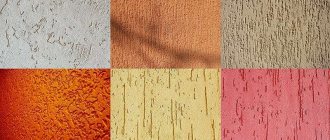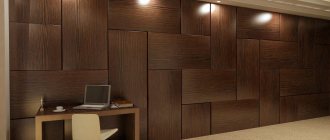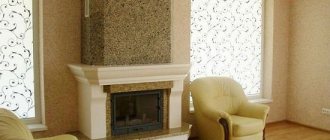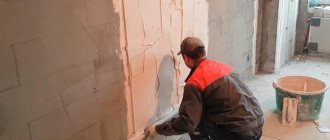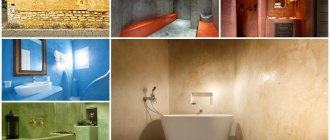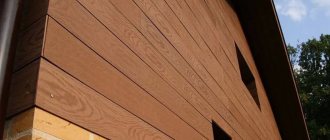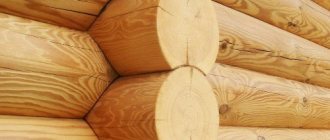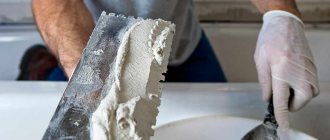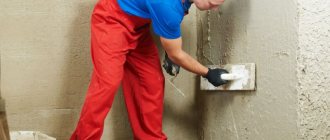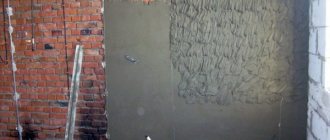Mosaic plaster - combines stone grains of different diameters and colors that create the illusion of a mosaic. It looks interesting and unusual. Buildings finished in this way look truly solid.
Natural ingredients and durability of the finish add weight and create a good reputation for the coating.
The main area where mosaic plaster is used is exterior decoration. The facades and plinths of various buildings “feel comfortable” under such protection: mosaic plaster is not afraid of atmospheric influences, withstands mechanical shocks well, and does not fade in the sun.
Mosaic plaster is also used quite widely inside buildings. But since its main component is stone, which is considered a “cold” material, it is usually used to decorate non-residential premises. It can be found in public buildings, entrances of residential buildings,
Where people live, mosaic plaster is perfect for baths, halls, and corridors. Wherever it is necessary to demonstrate increased resistance and durability, the coating shows undeniable advantages.
Facts of history.
In Ancient Greece, mosaic plaster was used to decorate floors and walls. It was often used to decorate temples and rich houses. This type of decoration was also common in Byzantium. Later they forgot about him.
It was remembered again in the thirteenth century when it was called "Florentine plaster". They actively decorated buildings with it - secular and religious. Then marble chips were added to the mixture, and not stone, as the ancient Greeks did. After the popularity of this type of decoration subsided again, it was revived again in the eighteenth century, thanks to Mikhail Lomonosov.
Russia still preserves samples from those times. The excellent performance qualities of such a stone “mosaic”, the speed and ease of its creation made the coating very popular at that time.
Different diameter.
The effect of mosaic plaster when using this material is achieved by mixing stone grains of different sizes, colors, and types of natural stone.
To do this, the acrylic binder is filled with natural stone chips. And also grains that are pre-colored. Mixan mosaic plaster, for example, includes selected colored quartz.
The filler can be granite, marble, or quartz chips. Sometimes crushed lapis lazuli and malachite are added. The coating is made even more respectable and original.
Interesting fact: when mixing ingredients of different types, an original mixture is obtained - each batch of the finished product has its own. It is practically impossible to repeat the proportions twice absolutely exactly.
Using plaster indoors
Material with a small filler fraction is well suited for interior decoration. Most often it is used for offices, private houses, balconies, corridors. No less relevant is plaster for the kitchen in the area of the sink and apron. The mosaic coating looks great on corners and arches, and it also protects such places from damage.
Mosaic plaster is applied to well-leveled walls that have been thoroughly dried beforehand. A prerequisite is to prime the base with quartz primer of a neutral shade. Typically, only one layer of material is sufficient indoors. The work is done with a spatula and trowel in the standard manner.
After application, the mixture is ground with a grater or rolled with a roller, sponge, or rubbed with a trowel. To get an interesting decor, stick a stencil on the wall, fill the inside with plaster, level it and polish it. After complete drying, the stencil is removed.
Types of material.
This plaster is divided into several types. Depending on the place of application, it happens:
- acrylic plaster for the basement: it is used to finish the basement of buildings; the grain size varies from 0.8 to 3 millimeters; mosaic plaster for the plinth can be used on a cement, gypsum, lime base;
- acrylic for facade: the composition may contain larger grains; it is possible to use crumbs of different colors;
- acrylic for interior decoration: the composition contains grains of various diameters and shades; It is used to decorate walls, columns, arches, and finish niches with it.
Important point:
Facade mosaic plaster is applied using the “wet on wet” method - a new layer is laid even before the previous one has dried.
Different types of material include different stone grain sizes:
- large - from one and a half to two millimeters;
- medium - with a diameter of 1.2-1.6 millimeters;
- small - with a grain of 0.8-1.2 millimeters;
- fine-textured, less than 0.8 millimeters in size.
Description and features
Depending on the particle size, the texture will be different:
- For interior work, a fine-grained mixture (0.8-2 mm) is well suited.
- Large granules (2.5-3 mm) look better on the base and facade walls.
Expert opinion
Marina Zanina
Interior designer
The peculiarity of this type of finishing is that the stone chips included in the plaster have a natural color and are not subsequently painted. The material is sold in buckets ready for use.
Examples of finishing are shown in the photo.
In the interior of the living room
On the walls of the landing
In two colors
Design with artificial stone
The advantages of mosaic plaster coatings include:
- Easy to apply.
- Increased moisture resistance.
- High elasticity (the mixture can be easily applied to complex surfaces).
- Resistant to sudden temperature changes and mechanical stress.
- Good vapor permeability and UV resistance.
- Attractive appearance, large selection of colors.
- Durability.
Flaws:
- Possible shedding of granules if application technology is violated.
- Fading in the sun after 15-20 years of use.
- High price. Cladding a house, for example, “like a bark beetle” will be significantly cheaper.
Mosaic plaster is used to decorate walls:
Facades and plinths
Balconies, corridors, entrances
Bathrooms
Residential premises
Based on the size of the mineral filler, the finishing material is divided into plaster with small, medium and large fractions.
Popular brands of manufacturers: Baumit, Wallmix, Ceresit ct 77, Mixan, Bayramix (Bayramix) and others.
The basis of popularity.
Mosaic plaster is quite popular today. The basis for its demand for finishing buildings outside and inside are several factors:
- Mosaic plaster does not fade in the sun for a very long time; ultraviolet rays are not able to destroy the color of natural stones;
- withstands natural disasters: snow, rain, wind, heat are not afraid of it; the coating retains its qualities after many cycles of freezing and thawing, which makes it a good choice for finishing buildings in regions with a sharply continental climate;
- allows steam to pass through, which allows the walls finished with it to “breathe”, and this is beneficial for humans;
- unpretentious in choosing a base: can be applied to stone, cement, foam concrete, plasterboard, plastered surfaces - provided that an appropriate primer layer is used;
- can be used for a long time without losing its aesthetic properties;
- features a wide range of colors; adding a dye to the binder allows you to obtain any shade;
- Plaster is made of moelastic, which allows you to relieve internal stress that arises in the plaster layer under external influence;
- easy to apply, without requiring special skills or high qualifications; Almost anyone can make such a coating;
- impact-resistant, well resistant to animal claws;
- easy to care for: can be washed, cleaned using different products; Bayramix mosaic marble plaster, for example, can be cleaned with chloramine: making it a suitable option for use in hospitals and food processing plants.
Drying and finishing
After application, the mosaic mixture should dry without stimulating the process, that is, naturally. Drying time – 48 hours (touch – 12 hours). Since there is an elevated temperature near batteries and radiators, they should be turned off or isolated.
Sometimes a varnish coating is applied as a protective layer. It gives the surface additional shine. However, it is not at all necessary. The varnish is selected in accordance with the base of the plaster mixture so that there is no chemical confrontation. The varnish is applied to the coating with a roller.
A few nuances.
The advantages that mosaic plaster has are accompanied by a number of points - they can be classified as disadvantages. So, it is quite expensive, which makes such finishing a rather expensive type of decoration. However, the costs are certainly justified by the long service life and good aesthetics.
In addition, its ability to pass steam, according to some experts, is not too high. This is confirmed by the manufacturers' instructions, which recommend not using this type of plaster where the walls of buildings are insulated using mineral wool slabs.
Durability is the main advantage
Basement is the base of a building that rests on a foundation. In strip foundations, the base is the upper part of the foundation itself. Also, the plinth is the lower belt of the facade. The presence of a belt protects the building from environmental influences and pollution. To achieve the best result, you need to choose the right material for processing the base. Treating the base part of the foundation not only provides protective properties, but also gives the walls of the house an irresistible appearance. The choice of material for finishing the base is the best solution.
Related article: Manual lifting equipment
Colored mosaic plaster
A durable layer of the mixture is applied to the base, while one rule is followed: the outer walls must be dry. This rule is due to the dense consistency of the mixture, through which water slowly evaporates. If this rule is violated, mold will form on the walls. Properly preparing the outside of the house for plastering is the key to the durability of mosaic plaster. The mixture, applied in a small amount to the wall of the building, turns out smooth and neat. Before starting the process, it is recommended to apply a layer of primer to the facade. The preparation process will help strengthen the base and regulate its ability to absorb moisture. Then the surface is leveled. Correctly completed preparation steps and the plastering process itself will allow you to achieve maximum stability of the exterior walls of the house.
Preparing the mixture.
Mosaic plaster is sold ready-made. It’s convenient – you can start working right away. Only the material must first be stirred well so that it is completely homogeneous. If you don’t know what to choose, we recommend using the popular and high-quality Ceresit plaster. There are also plenty of dry mixture options on the market. In this case, the composition is filled into a container into which water is poured in advance. Next, the solution is thoroughly mixed.
Expert advice:
It is better to buy the solution ready-made (diluted), this guarantees the exact proportions of water and mixture, and, therefore, its shade will be much more beautiful.
To ensure that the entire surface to be finished is the same shade, it is worth purchasing mosaic plaster from one batch. The color and composition of different batches may differ slightly, because it is almost impossible to achieve complete identity when producing this type of material. Therefore, it would be a good idea to ask the seller whether the package is from the same batch and check the labeling.
Expert advice:
If you cannot buy several packages released on the same day, or even better, in one hour, it is recommended to pour or pour the composition from different packages into one large container and mix well. Then the finished material will have a uniform structure and one shade throughout its entire volume.
Composition of plaster, its pros and cons
Decorative mosaic plaster may include the presence of different stones. Their type determines the name of the mixture. She may be:
- lapis lazuli;
- malachite;
- quartz;
- granite;
- marble.
Some types of mosaic plaster involve mixing different stones with each other, which allows you to get even more unexpected effects. Surfaces have a special structure if they are coated with a composition of elements of different fractions and rocks.
Attention! The basis can be different materials, this is not only light or heavy concrete, as well as brick and plasterboard, but also ordinary plaster.
Mosaic plaster may have a certain binder:
- mineral;
- acrylic;
- silicone.
The first option is the cheapest and requires the presence of cement or gypsum. The most common are acrylic solutions with high decorativeness and elasticity. Silicone mixtures include potassium glass, so the layer hardens very quickly.
Before using mosaic plaster for decoration, you should consider its pros and cons. Among the first are:
- UV resistance;
- resistance to damage;
- vapor permeability;
- versatility;
- strength;
- long service life;
- environmental friendliness;
- ease of application;
- ease of care.
The material is universal, which means it can be applied to almost any surface. It is offered for sale in a wide color palette, which can be combined with combined finishing materials or select a mixture separately according to your own taste.
But mosaic plaster also has its disadvantages. They consist in the high cost of the material, the inability to use it in conjunction with mineral wool or glass wool insulation, as well as low maintainability. As for the second factor, it can be explained by the fact that the composition may contain resins, which should not affect the mentioned insulation materials. Do not forget that facade plaster in some cases cannot be repaired. And if you do not have the appropriate skills, you will have to turn to professionals for application, which will be accompanied by additional costs.
Wet to wet.
| subroset |
Mosaic plaster for the plinth or facade, or internal, is applied using a trowel or a trapezoid-shaped trowel. Work can be carried out when the surrounding air is no colder than 8 degrees Celsius.
After applying the first layer, the second one is laid on it almost immediately. This method is called “wet on wet”. It is used because if you let the bottom layer dry, the joints of different layers will be visible, and this is not desirable.
If you want to combine areas lined with plaster of different colors and textures, the process becomes more complicated. First, the selected area is limited with masking tape. Then the mixture is applied. After 15-20 minutes, remove the tape. Allow the solution to dry for a day and a half - then finish the next section.
Each layer of mosaic plaster is laid with a thickness equal to the diameter of the grains. After finishing work, the surface should dry for two days. After this, the work can be considered completed.
Tools needed
To carry out the work of covering with mosaic plaster, you need to have the materials in the required quantity to finish a certain surface area, as well as tools and consumables:
- Grater, grater.
- Trowel, various spatulas.
- Roller with a textured base, stencil, stamp.
- Masking tape.
- Rough plaster.
- Primer and brush.
- Polyethylene film.
Consumption and price.
The average price at which the solution is sold is about 120 rubles per kilogram of the finished mixture. The price may be higher or lower, depending on what rock the stone chips are used from, what its density is, and what adhesion indicators a particular product has. The larger the grain diameter of mosaic plaster, the higher its consumption.
The difference can be 2-3 times - between the finest-grained and the coarsest-grained plaster material. Water absorption characteristics and resistance to low temperatures are also important.
This affects how much mosaic plaster will cost per square meter.
If we consider that 2-3.5 kilograms are spent per square meter, then the cost per square meter amounts to 200-300 rubles. At a consumption of 6 kg. The cost of the material will cost about 700 rubles per m². data-matched-content-ui-type=”image_stacked” data-matched-content-rows-num=”2″ data-matched-content-columns-num=”3″ data-ad-format=”autorelaxed”>
Technology and conditions of application to the façade and plinth
When carrying out repairs yourself, it is better to use ready-made mixtures from cans. When using dry material, it is diluted with water according to the instructions and brought to a homogeneous consistency using a construction mixer.
Mosaic plaster is applied with a stainless trowel, from one corner to another. The work must be carried out quickly, since if the applied mixture dries out, the joints between the sections will be visible to the naked eye. For even application, press the tool tightly against the wall and rub the mixture in a smooth motion.
“The thickness of the layer depends on the size of the crumb.”
